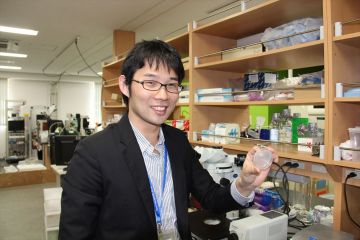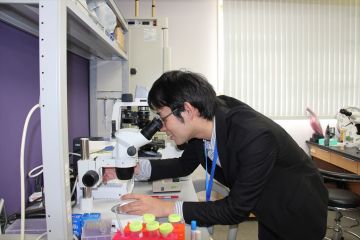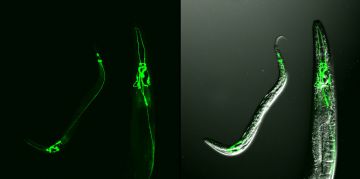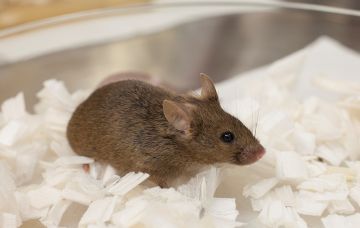TSUKUBA FUTURE
#040 Chasing Dreams
Assistant Professor HAYASHI Yu, International Institute for Integrative Sleep Medicine

Why do we sleep? Moreover, why do we dream? In truth, we do not really know the answers to these questions. However, an experiment from a quarter of a century ago showed that rats prevented from sleeping died after two to three weeks. The rats exhibited symptoms such as weight loss and decreased body temperature, but the direct cause of death is not known. Despite sleep being a phenomenon that we experience every night, we know almost nothing about it.
People often talk of sleeping so soundly that they did not even dream. However, normal sleep is a repeating cycle of non-REM sleep, during which we do not dream, and REM sleep, during which we are more prone to dreaming. REM is short for "rapid eye movement." This phenomenon was named in 1953 by American researchers who discovered that although a person may be sleeping soundly, there is still rapid movement of just the eyes beneath the eyelids. Later research showed that besides REM sleep, there is another type of sleep called non-REM sleep during which there is no eye movement. By waking up people in each of these states, researchers discovered that we mainly dream during REM sleep. When brain waves are monitored, brain waves during REM sleep appear as narrow and small waves like those seen during wakefulness whereas brain waves during non-REM sleep appear as unique waves that fluctuate widely (called "slow-wave"). In a normal sleep sequence, deep non-REM sleep comes first, then REM sleep, then alternating cycles of the two types. Although REM sleep has only been observed in mammals, it is said to also occur in birds. REM sleep does not occur in reptiles. Furthermore, no animal is known to only have REM sleep. The evolution of sleep quality is a very interesting topic.


Prof. Hayashi has worked with nematodes for a long time. He is culturing nematodes in the petri dish in his hand.
Prof. Hayashi is trying to find out why REM sleep is necessary. Sleep is believed to exist for the purpose of resting the body, but during REM sleep, the brain is highly active despite the muscles being relaxed. Why is this the case? Animals die if they do not sleep. If rats are allowed to sleep after being prevented from sleeping for a time, they continue sleeping as one would expect. For some reason, however, the percentage of REM sleep increases. Some studies also show that if you wake a person who has entered into REM sleep, they will sleep more lightly after that point and will be unable to sleep soundly, even if they transition to non-REM sleep. It may be that REM sleep is necessary to improve the quality of non-REM sleep. During deep non-REM sleep, secretion of growth hormone becomes more active. Growth hormone does more than simply promote growth in children; it is important for adults as well because it has anti-aging effects and promotes fat metabolism. However, the percentage of REM sleep is higher in newborns and decreases as children grow. Furthermore, it appears that the percentage of REM sleep is lower in people with certain types of developmental disorders. This only deepens the mystery.

These are pictures of neurons made to glow to enable research of neurogenesis in nematodes. The glowing substance is green fluorescent protein (GFP), which was discovered by Dr. Osamu Shimomura, an Eminent Professor at the University of Tsukuba who won the Nobel Prize for his work.
As a graduate student, Prof. Hayashi studied the plastic development of neural circuits in the elegantly (?!) named nematode C. Elegans, a model laboratory animal. After that, hoping to research more complex processes of brain development, he joined the RIKEN Brain Science Institute as a postdoctoral fellow. There he studied switches in the brain that trigger transitions between REM sleep and non-REM sleep. After becoming an assistant professor at the University of Tsukuba, he succeeded with much effort at creating mice that do not enter REM sleep as a tool for exploring the mysteries of REM sleep. This was made possible by manipulating a special switch in the brain. He plans to use this tool to conduct more substantial research in the future.
While he continues his experiments with mice, he is also conducting experiments with nematodes using his past experience. Actually, depending on how you define "sleep," you could say that nematodes also sleep. By this definition, "sleep" is a state of stillness during which responses to external stimuli weaken but a state of "wakefulness" can be promptly induced by a strong stimulus and rebound occurs after continuous interruption. A state that fits this definition is not seen in plants at the very least. Nematodes molt four times during their lifecycle. Right before they molt, they stop moving completely. You might say that this is "sleep" for nematodes. In insects, this state right before molting is called "lethargus." Nematodes will also die if they are inhibited into lethargus by stimulating. This closely resembles sleep in mammals. Although nematodes are soil animals by nature, they can survive by eating large intestinal bacteria when cultured in medium on a petri dish in a laboratory. If provided with highly nutritious food, they stop moving. It is as if they become full and get sleepy. Prof. Hayashi is conducting research to re-examine such behavioral patterns in nematodes from the perspective of "sleep." Researchers at the International Institute for Integrative Sleep Medicine are searching for genes related to sleep. They are already being discovered in mice. Prof. Hayashi plans to search for potential key genes in nematodes as well. He hopes that discoveries from such research will help elucidate the evolution of sleep mechanisms.

As animals are defenseless during sleep, even laboratory animals will not sleep in front of humans. (Image provided by Assistant Professor Masataka Sasabe, IIIS)
Article by Science Communicator at the Office of Public Relations


